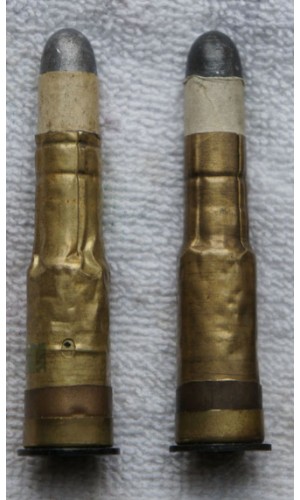Rifle Ammunition Boxer MkIII
| Date of Approval | 1st October 1873 |
| Length | Length: <3.2” (82mm) |
| Weight | Weight per pack 10: 1lb 2oz Bullet: 480g Paper patched white |
During the field trials between 1872 and 1873 of the short Chamber Martini Henry rifle, the arsenal at Woolwich provided a manufactured form of the Eley Cartridge known as the Mk1, listed as the Cartridge Small Arm, Ball, Boxer Henry. .450 inch, Martini Henry, Short Chamber Mk1. the bullet was held by a single, annular cannelure and only had one base cup., The lack of strength afforded by the single base cup was identified as a weak spot, Declared obsolete by 1881, with any ammunition in stores being withdrawn and subsequently broken up.
Introduced 1st October 1873, List of Change 2661 as the Cartridge, Small Arm, Ball, Rifle, Breech loading, Martini Henry Mark III. This cartridge was to become the standard military cartridge for the Martini rifle for the next twenty years. The powder chosen was R.F.G.2, manufactured at the Royal Gunpowder Mills at Waltham Abbey, Essex. Rifled Fine Grain 2, (R.F.G 2) was a quite coarse granular black powder that was graded through meshes approximately 12-14 meshes per inch.
To Overcome the Mk1’s boxer cartridges’ design weaknesses, the MkIII round was manufactured in a thicker brass sheet .0004” thick, internally an additional inner coil of brass was laminated into the bottom third of the case to re-enforce the joint, to ensure the inner strip had been fitted, a small “view hole” was made in the case wall, ensuring the inspector could visibly see the presence of this strip. To strengthen the case further, a second base cup was added. the bullet was seated with two annular rings to clasp the bullet. Above the powder a beeswax plug lubricated the bore to prevent fouling and two millboard discs separated the bullet. (see cut-away image).
The ammunition into bundles of ten rounds, five wide, two high, and packed heads to tails. Between each round a thin white paper kept the rounds separated and the complete bundle was then tied into a parcel with twine.
The label formed part of the quality control, listing the description of the cartridge, Cartridge Ball S.A (small arm), the type B.L Martini Henry Rifle, the manufacturer R^L, the date of manufacture i.e 1877 and the Mark III. On 16th August 1880 to make the identification of the packaging of the cartridges easier, a method of colour coding of the packets label were introduced, subsequent packages were have a Red rectangle added to the label for rifle and a hollow red rectangle for carbine.





